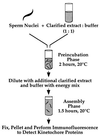A method that allows the assembly of kinetochore components onto chromosomes condensed in clarified Xenopus egg extracts
- PMID: 9356457
- PMCID: PMC24953
- DOI: 10.1073/pnas.94.23.12378
A method that allows the assembly of kinetochore components onto chromosomes condensed in clarified Xenopus egg extracts
Abstract
Kinetochores are complex macromolecular structures that link mitotic chromosomes to spindle microtubules. Although a small number of kinetochore components have been identified, including the kinesins CENP-E and XKCM1 as well as cytoplasmic dynein, neither how these and other proteins are organized to produce a kinetochore nor their exact functions within this structure are understood. For this reason, we have developed an assay that allows kinetochore components to assemble onto discrete foci on in vitro-condensed chromosomes. The source of the kinetochore components is a clarified cell extract from Xenopus eggs that can be fractionated or immunodepleted of individual proteins. Kinetochore assembly in these clarified extracts requires preincubating the substrate sperm nuclei in an extract under low ATP conditions. Immunodepletion of XKCM1 from the extracts prevents the localization of kinetochore-associated XKCM1 without affecting the targeting of CENP-E and cytoplasmic dynein or the binding of monomeric tubulin to the kinetochore. Extension of this assay for the analysis of other components should help to dissect the protein-protein interactions involved in kinetochore assembly and function.
Figures






References
Publication types
MeSH terms
Substances
Grants and funding
LinkOut - more resources
Full Text Sources

